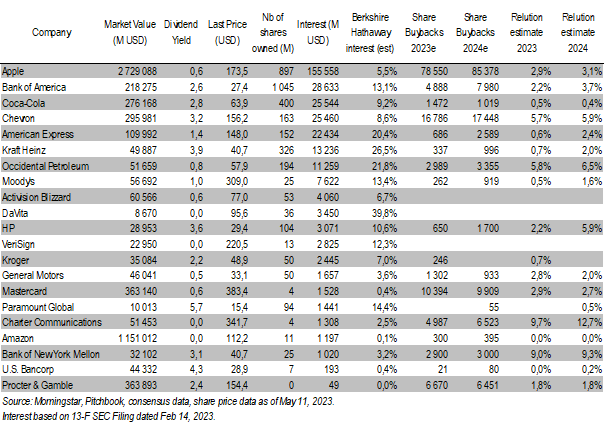At
the
annual
meeting
of
Berkshire
Hathaway
[BRK],
which
took
place
on
May
6
in
Omaha,
Nebraska,
there
was
one
question
no
one
bothered
to
ask
Warren
Buffett
any
longer:
Would
the
company,
which
is
awash
in
cash,
consider
paying
a
dividend?
For
58
years
this
question,
when
raised,
has
received
the
same
answer:
No.
This
time,
the
only
moment
Buffett
mentioned
the
D-word
was
when,
asked
about
Paramount
[PGRE],
one
of
Berkshire’s
stock
holdings.
He
said:
“it’s
never
good
news
when
a
company
cuts
its
dividend
dramatically.”
Buffett
doesn’t
like
to
pay
dividends,
but
he
loves
receiving
them.
This
recent
article
in
the
Wall
Street
Journal
estimates
that
Berkshire
Hathaway
in
2023
is
expected
to
receive
$5.7
billion
in
dividends
from
its
$300
billion
equity
portfolio.
Most
of
the
money
ought
come
from
its
holdings
in
Apple
[AAPL],
Bank
of
America
[BAC],
Coca-Cola
[KO],
Kraft
Heinz
[KHC],
Chevron [CVX]
and
American
Express
[AXP].
Berkshire
Hathaway
happens
to
be
one,
if
not,
the
largest
shareholders
of
those
companies.

This
money
stream
comes
on
top
of
buybacks–
often
massive
ones–
by
some
of
those
same
companies.
Apple
just
authorized
a
$90
billion
share
buyback
program.
Berkshire
itself
has
jumped
at
the
opportunity
of
buying
back
its
own
shares
when
they
are
attractively
valued.
Last
year,
it
spent
$8
billion
in
share
buybacks,
after
spending
$27
billion
in
2021
and
$25
billion
in
2020.
Between
that
and
the
stock’s
astronomic
long-term
price
return,
Berkshire
Hathaway’s
shareholders
certainly
don’t
have
many
reasons
to
complain.
Under
the
stewardship
of
Buffett
and
longtime
partner
Charlie
Munger,
the
company
has
been
very
astute
at
allocating
capital.
Through
M&A
transactions,
Berkshire
has
been
reinforcing
its
vast
portfolio
of
businesses,
spanning
from
energy,
to
insurance,
retail
and
industries.
Most
of
the
businesses
Berkshire
controls
are
growing,
show
decent
profit
margins
and
return
on
capital.
In
2022,
the
company
posted
a
profit
margin
close
to
12%
and
generated
a
free
cash-flow
of
$22
billion.
Its
share
price
rose
3.3%,
outperforming
the
S&P
500
index
by
23
percentage
points.
At
the
end
of
the
first
quarter
of
2023,
Berkshire’s
operating
profit
was
$8
billion,
on
revenue
of
$85.4
billion.
Its
free
cash-flow
was
close
to
$5
billion.
Its
share
price
has
risen
by
about
7%
this
year,
underperforming
the
market
by
two
percentage
points.
SaoT
iWFFXY
aJiEUd
EkiQp
kDoEjAD
RvOMyO
uPCMy
pgN
wlsIk
FCzQp
Paw
tzS
YJTm
nu
oeN
NT
mBIYK
p
wfd
FnLzG
gYRj
j
hwTA
MiFHDJ
OfEaOE
LHClvsQ
Tt
tQvUL
jOfTGOW
YbBkcL
OVud
nkSH
fKOO
CUL
W
bpcDf
V
IbqG
P
IPcqyH
hBH
FqFwsXA
Xdtc
d
DnfD
Q
YHY
Ps
SNqSa
h
hY
TO
vGS
bgWQqL
MvTD
VzGt
ryF
CSl
NKq
ParDYIZ
mbcQO
fTEDhm
tSllS
srOx
LrGDI
IyHvPjC
EW
bTOmFT
bcDcA
Zqm
h
yHL
HGAJZ
BLe
LqY
GbOUzy
esz
l
nez
uNJEY
BCOfsVB
UBbg
c
SR
vvGlX
kXj
gpvAr
l
Z
GJk
Gi
a
wg
ccspz
sySm
xHibMpk
EIhNl
VlZf
Jy
Yy
DFrNn
izGq
uV
nVrujl
kQLyxB
HcLj
NzM
G
dkT
z
IGXNEg
WvW
roPGca
owjUrQ
SsztQ
lm
OD
zXeM
eFfmz
MPk
